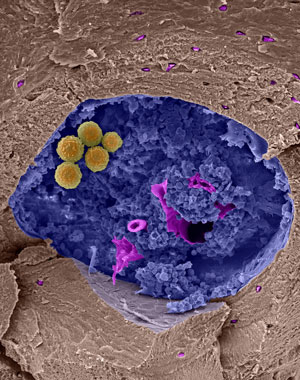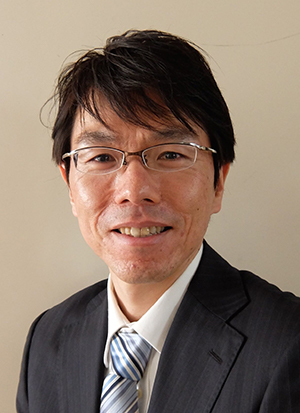Apr. 27, 2018 Research Highlight Biology
Three transcriptional circuits found between hematopoietic stem cells and B cells
B cells pass through three distinct gene expression networks on their way from stem cell to B cell
 Figure 1: Colored scanning electron micrograph of bone marrow cavity containing hematopoietic human stem cells (yellow spheres; the stems cells are shown at a higher magnification than the bone marrow cavity). © DENNIS KUNKEL MICROSCOPY/SCIENCE PHOTO LIBRARY
Figure 1: Colored scanning electron micrograph of bone marrow cavity containing hematopoietic human stem cells (yellow spheres; the stems cells are shown at a higher magnification than the bone marrow cavity). © DENNIS KUNKEL MICROSCOPY/SCIENCE PHOTO LIBRARY
By analyzing the expression of thousands of genes, RIKEN researchers have shed light on how a stem cell grows up to become a certain type of immune cell1. This knowledge will inform future research into B cell leukemia.
B cells are a type of white blood cell, and they help the body fight infections by producing antibodies. They start off life as hematopoietic stem cells (HSCs)—stem cells that go on to become blood cells.
Tomokatsu Ikawa of the RIKEN Center for Integrative Medical Sciences has long been interested in understanding the differentiation process that commits a stem cell to the fate of becoming a B cell. “Key transcription factors have been identified, but the underlying mechanisms remain to be revealed,” he notes.
To discover how the expression of genes changes as an HSC becomes a B cell, Ikawa’s team used a cell system they had previously developed: the induced leukocyte system. It consists of multipotent progenitor cells—stepping stones between stem cells and mature cells—that can be efficiently differentiated into B cells by triggering the expression of the protein E2A, which is a transcription factor essential for priming HSCs toward the B cell lineage. This cell system allowed Ikawa’s team to synchronize the differentiation process and examine the cells’ transcriptome at various time points.
When the team analyzed the expression of thousands of genes, they saw distinct waves of expression as cells committed to the B cell lineage. They combined data on the transcription factors that were active in each wave and the genes they regulated with epigenetic data of histone marks. This allowed the researchers to construct three distinct networks: the early network of multipotent progenitor cells, a transitional state and the network of committed B cells.
 Tomokatsu Ikawa and co-workers have found that a hematopoietic stem cell goes through three distinct transcriptional networks on its way to becoming a B cell. © 2018 RIKEN
Tomokatsu Ikawa and co-workers have found that a hematopoietic stem cell goes through three distinct transcriptional networks on its way to becoming a B cell. © 2018 RIKEN
While all these data were originally obtained from cells differentiated in a culture dish, the team saw the same expression patterns in B cell progenitors isolated directly from the bone marrow.
“We were surprised to find that the B cell lineage commitment process could be separated into three main stages based on messenger RNA expression profiles,” recalls Ikawa.
Ikawa now wants to explore the metabolic pathways and non-coding RNA that underlie the development and function of immune cells; he is particularly interested in the role of long non-coding RNAs in the regulatory process.
Ikawa and his team are focusing on normal B cell development, but he predicts that this approach can also be used to study the mechanism by which B cell leukemia develops. “The more we understand this process, the more likely efficient points of intervention will be found,” Ikawa comments.
Related contents
- To B or not to B
- Blocking differentiation is enough to give cells “stemness”
- Molecular structure of elongation complex essential for DNA transcription determined
References
- 1. Miyai, T., Takano, J., Endo, T. A., Kawakami, E., Agata, Y., Motomura, Y., Kubo, M., Kashima, Y., Suzuki, Y., Kawamoto, H. et al. Three-step transcriptional priming that drives the commitment of multipotent progenitors toward B cells. Genes & Development 32, 112−126 (2018). doi: 10.1101/gad.309575.117
